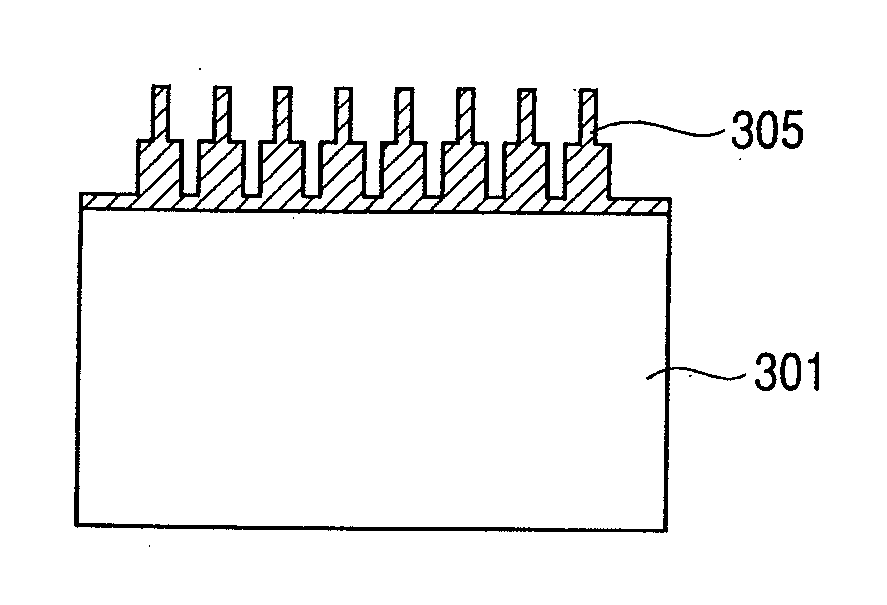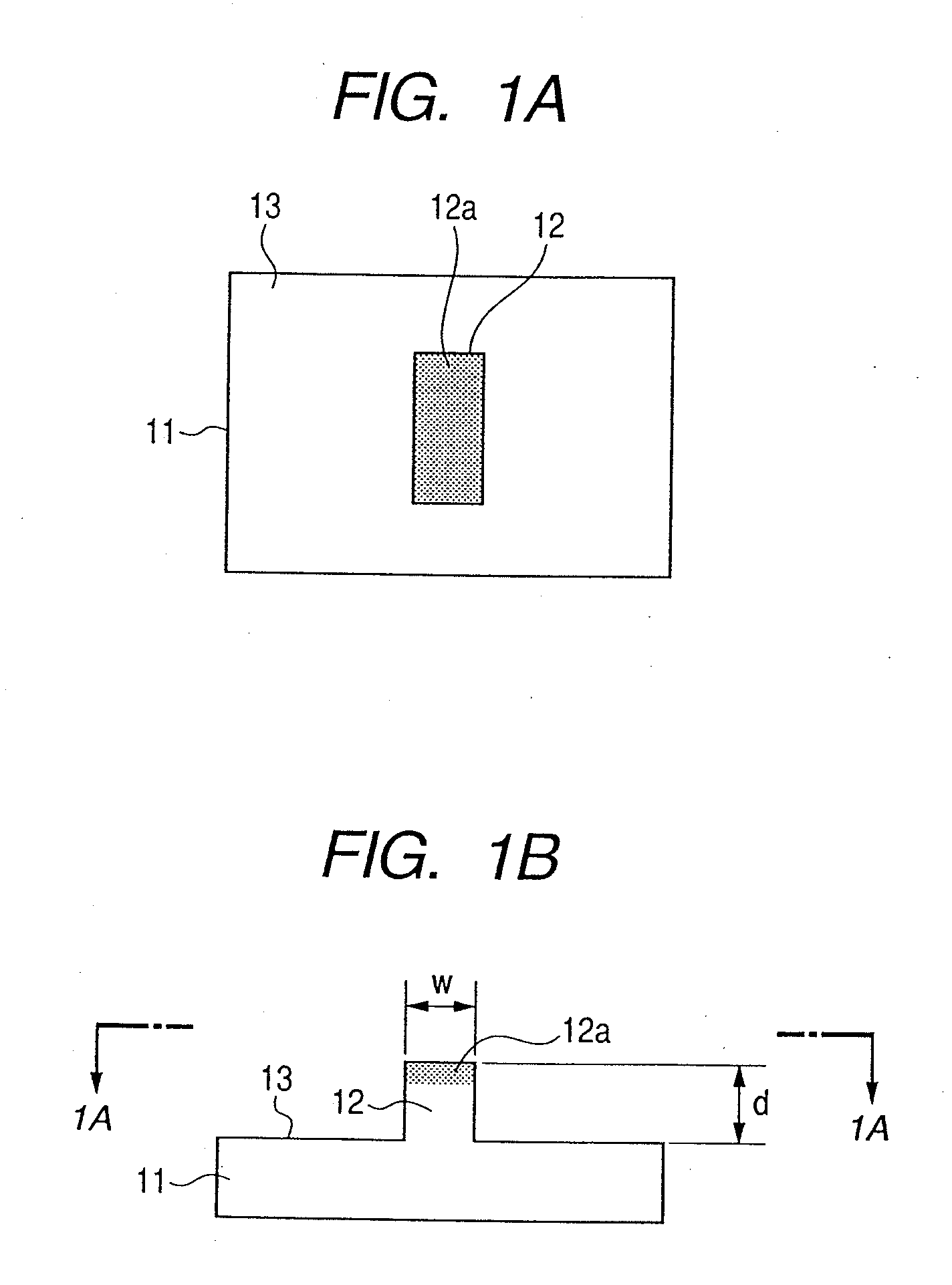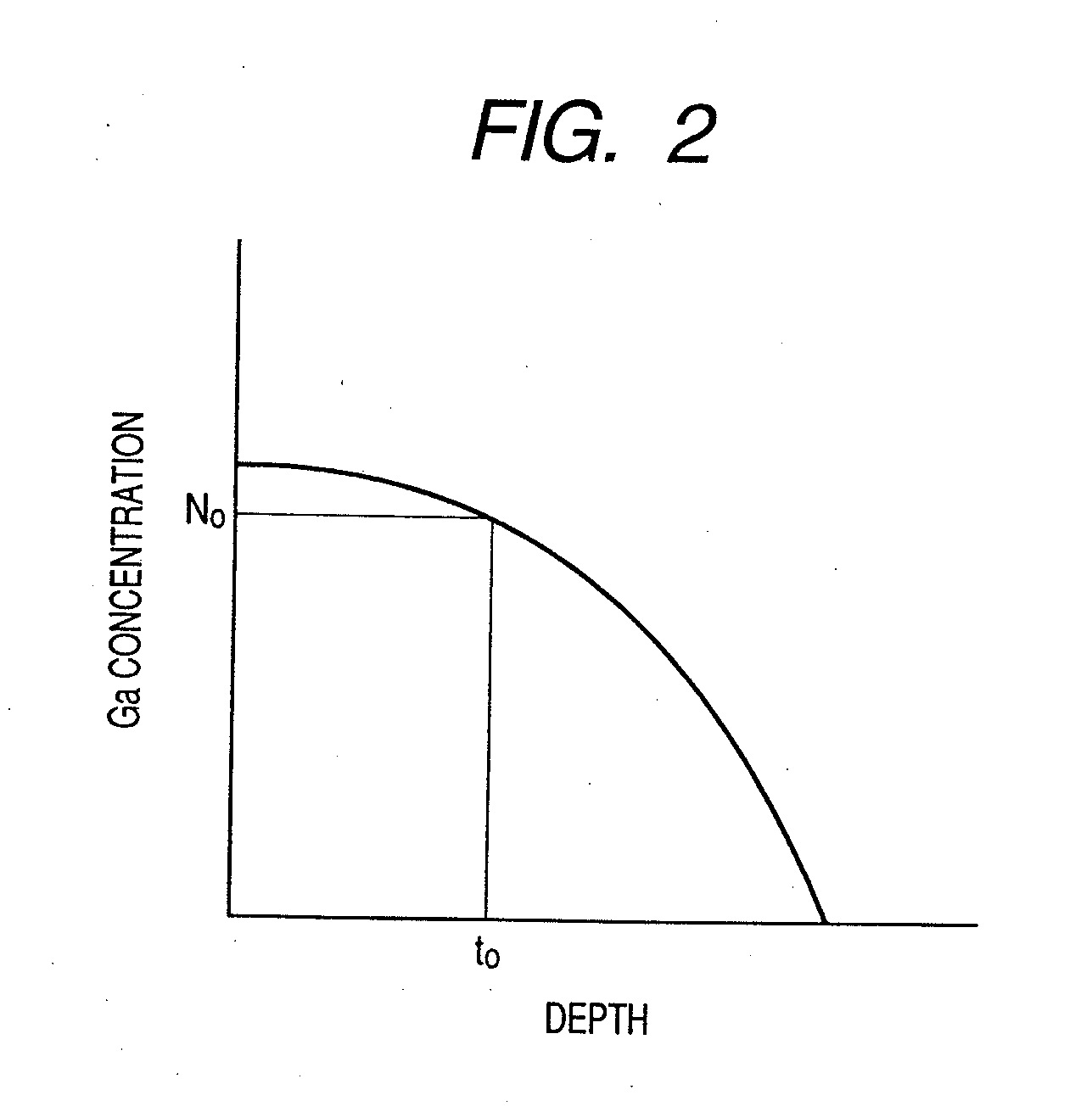Method of Manufacturing A Nano Structure By Etching, Using A Substrate Containing Silicon
a nano-structure and nano-etching technology, applied in nanotechnology, nanoinformatics, electric devices, etc., can solve the problems of difficult to form patterns having a line width half or less than the wavelength of the light source being used, and particularly difficult to form patterns having a line width of 500 nm or less,
- Summary
- Abstract
- Description
- Claims
- Application Information
AI Technical Summary
Benefits of technology
Problems solved by technology
Method used
Image
Examples
first embodiment
[0080]Next, a nano structure and a method of manufacturing the nano structure in a first embodiment of the present invention, to which a pattern forming method of the present invention is applied, will be described.
[0081]With reference to FIGS. 1A and 1B, a configuration example of the nano structure having a pattern containing a desired Ga on the surface of a substrate containing Si in the present embodiment will be described. FIG. 1A is a top plan view and FIG. 1B is a sectional view.
[0082]In FIGS. 1A and 1B, reference numeral 11 denotes a substrate, reference numeral 12 denotes a pattern, reference numeral 12a denotes a pattern surface, and reference numeral 13 denotes an etching bottom.
[0083]In the nano structure in the present embodiment, as the substrate 11, a substrate containing Si is used.
[0084]For example, not only a single substrate such as silicon, SiO2, and SiN, but also, a silicon film on SiO2, an SiN film on SiO2, an SiO2 film on silicon, an SiN film on silicon, a sil...
second embodiment
[0131]Next, a method of manufacturing a nano structure for manufacturing the nano structure having a convexo-concave pattern by a predetermined pitch on the substrate surface by etching by using a substrate containing Si in a second embodiment of the present invention will be described.
[0132]FIGS. 5A, 5B, and 5C are views describing a pattern forming method in the present embodiment.
[0133]In FIGS. 5A, 5B, and 5C, reference numeral 21 denotes a substrate containing Si, reference numeral 22 denotes a pattern, reference numeral 22a denotes a pattern surface, reference numeral 23 denotes an etching bottom, reference numeral 24 denotes a focused ion beam (FIB), reference numeral 25 denotes an FIB irradiated area, and reference numeral 26 denotes a reactive ion etching.
[0134]Further, in FIG. 6, one example of the irradiation condition of the focused ion beam (FIB) in the pattern forming method of the present embodiment is illustrated.
[0135]In FIG. 6, to the same regions as the regions sho...
example 1
[0157]In a first example 1, one example of fabricating a nano structure illustrated in FIGS. 1A and 1B will be described.
[0158]As the substrate 11, the Si substrate was used. The pattern width W was taken as 100 nm, and the etching depth was taken as 20 μm.
[0159]Since the manufacturing method of the nano structure in the present example is basically by the same process as the manufacturing method of the nano structure illustrated in FIGS. 4A, 4B, and 4C described in the embodiment of the present invention, a description will be made here by using FIGS. 4A, 4B, and 4C also.
[0160]First, the Si substrate 11 is set to the focused ion beams (FIB) apparatus (FIG. 4A). At that time, the Si substrate 11 is set so as to be vertical to the focus ion beam (FIB) 14. Although the focused ion beam (FIB) 14 is suitably adjusted in advance, before the irradiation, accuracy was confirmed in the substrate edge vicinity.
[0161]Five irradiation areas of 10 μm in length and a width W=100 nm are set in th...
PUM
| Property | Measurement | Unit |
|---|---|---|
| depth | aaaaa | aaaaa |
| wavelength | aaaaa | aaaaa |
| wavelength | aaaaa | aaaaa |
Abstract
Description
Claims
Application Information
 Login to View More
Login to View More - R&D
- Intellectual Property
- Life Sciences
- Materials
- Tech Scout
- Unparalleled Data Quality
- Higher Quality Content
- 60% Fewer Hallucinations
Browse by: Latest US Patents, China's latest patents, Technical Efficacy Thesaurus, Application Domain, Technology Topic, Popular Technical Reports.
© 2025 PatSnap. All rights reserved.Legal|Privacy policy|Modern Slavery Act Transparency Statement|Sitemap|About US| Contact US: help@patsnap.com



